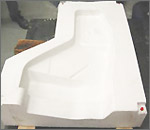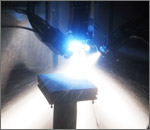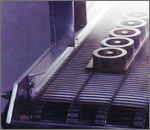Introduction: Freeze casting, is the process of making strong solid casting from powdered metals. This process which takes place at freezing temperature, is comparatively cheaper to l

ost wax process and sintering process. The advantage of the process over comparative processes is that the production is cheaper and the castings are an accurate replica of the original designs.
Freeze casting which is yet to be understood in detail, has been a process that is naturally occurring. A product called laminar opaoline silica is formed by the freeze casting of volcanised ash.
Process:
The
freeze casting process is done by making freezing water in rubber molds to make temporary ice patterns. These patterns are invested in ceramic slurries to make a shell that can be fill with powdered metal mixed with water and silica. Ice making costs only three to five cents per pound, including the cost of water and additives. Therefore, FCP can produce investment-quality castings for the price of sand castings.
The process involves the mixing of silica solution with a filler powder. For eg. if we are making component out of alumina, alumina oxide, then we would use silica solution with alumina as the filler powder. A wetting agent is also added for the proper dispersal of the filler powder through out the solution. Mostly water is used as the wet solution. Thus, a mixture is made of the silica, filling ag

ent and the sol to make a stiff dough. The mixture is highly thixotropic, which means that this sold combination will become liquid when shaken vibrantly. The dough is shaken vibrantly in the mold to remove the gas present and then kept for freezing. On freezing the solution converts to form a gel that hold the solid particles together. This solid frozen component is then dried in a furnace to form the casting.
The science being the process: In
freeze casting, the solid metal particles disperse in water. But when the water is frozen, the solid particles are rejected because the particles are not soluble in ice. Gradually, as the ice grows, the sold particles bond with each other. They are initially repulsive but by the end of the process they are locked in a strong bond which is irreversible strong solid structure. When the mold is dried in the furnace, the water melts, but the solid structure in retained. The strong structure can be further strengthened by heat treatment.
Application: Gray iron, ductile iron, steel, aluminum and copper can be used to cast products using
freeze casting process. Some of the products that are produced are automoti

ve and other parts, tooling dies, products that require hard working surface, casting products which require zero thermal expansion, etc. Freeze-cast components, in their basic form, are ideal for use as heat-resisting objects.
Advantage:
- A simple and inexpensive process, where dangerous casting machine are not used
- Complex shapes can be cast that require zero machining
- Casted products are light weight, have accurate dimensional tolerance and excellent surface finish
- Near-net shapes can be achieved for the castings
- Nearly half the cost of casting as compared to sand casting, lost wax or lost foam techniques.


